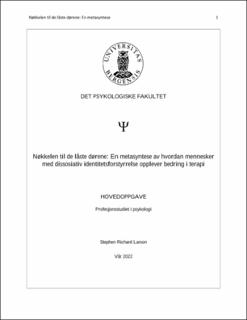| dc.contributor.author | Larson, Stephen Richard | |
| dc.date.accessioned | 2022-06-16T01:13:56Z | |
| dc.date.available | 2022-06-16T01:13:56Z | |
| dc.date.issued | 2022-05-19 | |
| dc.date.submitted | 2022-06-15T22:00:49Z | |
| dc.identifier.uri | https://hdl.handle.net/11250/2998927 | |
| dc.description.abstract | Dissosiativ identitetsforstyrrelse er en psykisk lidelse som vurderes å være på den alvorlige side av dissosiasjonslidelses-spektrumet. Denne hovedoppgaven brukte en metaetnografisk tilnærming for å besvare problemstillingen “Hvordan opplever personer med DID at terapi har bidratt til bedring?”. Teoretiske tilnærminger til etiologien av dissosiativ identitetsforstyrrelse blir gjort rede for. Faseorientert traumebehandling forklares ettersom det er den tilnærmingen som blir anbefalt av “The International Society for the Study of Trauma and Dissociation” (2011). Et litteratursøk identifiserte 8 kvalitative studier som oppfylte kriteriene for å inkluderes i denne metaetnografi. Noblit og Hare anbefaler tre nivå med analyse (1988; 1999), og hver av disse ble brukt her. En gjensidighetsanalyse identifiserte tre metaforer; Opplevelse av terapeuten som en trygg person, Dette blir en lang prosess, og De terapeutiske relasjonene. En refutasjonsanalyse identifiserte to metaforer; Hvor går grensen? og Ikke jakt etter sannheten. Til slutt ble en lines-of-argument analyse brukt, og fire metaforer ble funnet; Et kart over ukjent territorium, Trygghet som nøkkelen til de låste dørene, Å finne fram til verktøyene som fungerer, og La pasienten vise veien til bedring. Disse funnene ble diskutert både i forhold til hverandre og til forskning på psykoterapi, ikke minst forskning på terapi med mennesker med en dissosiativ identitetsforstyrrelse diagnose. | |
| dc.description.abstract | Dissociative identity disorder is a psychological disorder considered to be on the severe end of the dissociative disorder spectrum. This dissertation used a meta-ethnographic approach to answer the research question, “How do people with dissociative identity disorder experience that therapy has aided their recovery?” Theoretical understandings of the etiology of dissociative identity disorder are presented. Multi-modal, phasic, trauma-focused therapy is explored as this is the therapy recommended by the International Society for the Study of Trauma and Dissociation (2011). A literature search identified 8 qualitative studies that met the criteria to be included in the meta-ethnography. Noblit and Hare recommend three levels of analysis, each of which was used here. A reciprocal translational analysis identified three metaphors; Experience of the therapist as a safe person, This will be a long process, and The therapeutic relationships. A refutational analysis identified two metaphors; "Where are the boundaries?”, and “Don’t hunt after the truth”. Finally, a lines-of-argument analysis found four metaphors; A map of uncharted territory, Safety is the key to the locked doors, Retrieving tools that work, and Let the patient show you the way. These findings are discussed in light of each other and of previous findings from research on psychotherapy and specifically therapy with people who have received a dissociative identity disorder diagnosis. | |
| dc.language.iso | nob | |
| dc.publisher | The University of Bergen | |
| dc.rights | Copyright the Author. All rights reserved | |
| dc.subject | metaetnografi | |
| dc.subject | traumebehandling | |
| dc.subject | Dissosiativ identitetsforstyrrelse | |
| dc.subject | metasyntese | |
| dc.title | Nøkkelen til de låste dørene: En metasyntese av hvordan mennesker med dissosiativ identitetsforstyrrelse opplever bedring i terapi | |
| dc.type | Master thesis | |
| dc.date.updated | 2022-06-15T22:00:49Z | |
| dc.rights.holder | Copyright the Author. All rights reserved | |
| dc.description.degree | Hovedoppgave psykologprogrammet | |
| dc.description.localcode | PROPSY317 | |
| dc.description.localcode | PRPSYK | |
| dc.subject.nus | 736102 | |
| fs.subjectcode | PROPSY317 | |
| fs.unitcode | 17-0-0 | |
